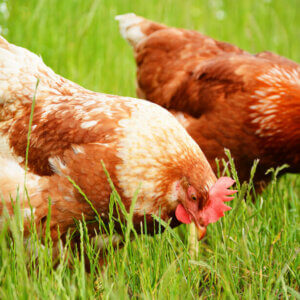
- Purpose: Eggs
- Eggs: White
- Egg Size: Extra Large
- Color: Brown, Black, White
- Comb Type: Single
Leghorns are to eggs as Broiler breeds are to meat. Every egg you buy at a big-box grocery store is laid by an industrial White Leghorn hen–though the health and well-being of many of those battery birds leaves much to be desired. Home-raised White Leghorns living a healthy life, however, will reward you with eggs upon eggs in thanks!
These inquisitive, active birds aren’t broody, resulting in year-round egg production. They are fast growing and are extraordinarily efficient at converting food into eggs, so they are an economical choice for the egg-producing farm. If you’re looking to make some money from your flock, these industrious birds may be the ones for you!
If you like the looks and just don’t have the space, there is also a bantam variety of Leghorn that might be the perfect fit for your backyard. The smaller chickens are also a touch more docile than their bigger counterparts.
Characteristics
The bright orange-red hackles, flame-red single comb, and iridescent green sickle feathers of a Red Leghorn rooster are a synonymous symbol with everything rural.
Even those with no knowledge of chickens could identify a Leghorn–the image is found everywhere, from “Welcome Home” signs to sports mascots. The white variety of the Leghorn is just as widespread, too. If you eat eggs, you’ve eaten one from a Leghorn, guaranteed!
Not The Cuddliest Of Chickens…
Leghorns are known for their eggs, not necessarily their cuddles. Prone to being very active and flighty, as well as decent at flying, they might be a little difficult to handle. They also tend to be rather noisy, so the best situation for these birds would be a large area where they can flap and cluck the day away.
Though they tolerate heat and cold reasonably well, their large combs are a little prone to frostbite –many keepers put a layer of protective petroleum jelly on their birds through the colder months.
They are also the source of a huge schism of purpose. The breeders of the past had different goals for the bird–some chose to breed it entirely to maximize egg production, resulting in the white egg-layer that has been both used and abused in commercial carton-filling.
Others–typically small farm owners– bred it for looks and vitality, resulting in the gloriously feathered, proud birds of farm iconography. They are a complicated breed!
What’s The Yield?
Leghorn hens are fantastic layers–often providing an egg every day. Typically, a healthy hen can lay 200-300 extra-large, pearly white eggs in a year. They are a medium-sized chicken, with roosters hitting 6 pounds and hens reaching 4 or 5 pounds.
Not the best for pets or for meat, these are egg-layers predominantly.
Facts About Leghorns
Leghorns are the most numerous poultry in the United States. Originally from Northern Italy, where there are ten different recognized colorations, they were bred near the port of Leghorn, from which they derive their name. The name, incidentally, is pronounced “Leggern.”
Pictures Of Leghorn Chickens
Resources
- 5 Reasons To Love Leghorn Chickens, Backyard Chicken Coops
- Leghorn (White), My Pet Chicken
- Poultry Breeds – Leghorn Chickens, Oklahoma State University
- Leghorn, Backyard Chickens
- Leghorn – Non Industrial – Chicken, The Livestock Conservancy
- Leghorn, Poultry Hub
- Leghorn Chickens – Popular Amongst Chicken Breeds, Leghorn Chickens
- The Leghorn, or Livorno, Chicken, Raising Happy Chickens
- Chicken Breeds: Leghorns, HGTV
- Leghorns, Featersite
- “Battery” Hens, United Poultry Concerns







































